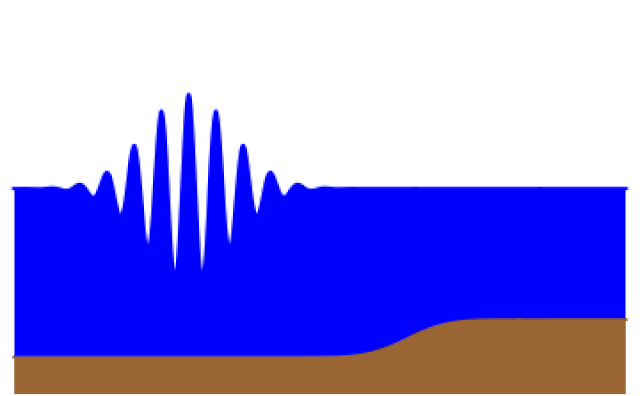
Tsunamis
The start of this month saw the marking of World Tsunami Awareness Day. Following up on this subject, let’s explore what a tsunami actually is and discover the stories of some of the most devastating in history.
The word ‘tsunami’ is Japanese, meaning ‘harbour wave’. Tsunamis are essentially large waves caused by oceanic earthquakes or volcanoes. When an earthquake occurs, or there is a volcanic eruption deep under the ocean, the water around it is displaced and often forms a large wave. As the wave moves closer and closer to land it grows taller as the ocean shallows close to shore (as shown in the visual above.) Not all earthquakes and volcanoes will cause a tsunami but one way to predict them is if the water at the shore begins to quickly recede after an earthquake. Tsunamis can be hundreds of feet tall and travel extremely quickly, so they can be incredibly destructive for the areas affected by them. Below are a couple of examples of some of the worst to have been recorded.
Sumatra, Indonesia, 2004
One of the deadliest tsunamis ever occurred off the coast of Sumatra on the 26th December 2004. A magnitude 9.1 earthquake created a wave that towered 50m tall and reached 5km inland. It is estimated to have cost around US$10 billion of damage and killed around 230,000 people.
North Pacific Coast of Japan, 2011
Another of the more recent tsunamis to have caused a great deal of devastation struck the coast of Japan on the 11th of March 2011, having begun with a 9.0 magnitude earthquake. With waves 10m high and arriving at an especially rapid speed of 800km per hour, this tsunami killed more than 18,000 people and displaced around 452,000 whose homes had been destroyed. As well as generating the tsunami, this earthquake caused a nuclear emergency at the nearby Fukushima Daiichi power plant, which began to leak dangerous radioactive steam. The damage that this natural disaster caused is estimated to have been in the region of $235 billion.
Krakatau, Indonesia, 1883
As mentioned, tsunamis are not only caused by earthquakes. The Krakatau, or Krakatoa, volcano is located on a small Indonesian island in the Sundra Strait between the larger ones of Java and Sumatra. When it erupted on the 27th of August 1883, it caused waves as high as 37m to form. This tsunami destroyed the towns of Merak and Anjer on Java, and its effects were felt as far away as India and Sri Lanka too. The event killed around 40,000 people in total, though many of those deaths were directly caused by the volcano, rather than the tsunami.
Lisbon, Portugal, 1755
Tsunamis don’t just occur in East and South-East Asia. On the 1st of November 1755, three waves struck the west coast of Portugal and southern Spain. These tsunamis, which reached up to 30m high, together with the earthquake that caused them, killed around 60,000 people in Portugal, Spain and Morocco.
For more information about tsunamis, and of the most powerful in history, visit What Is a Tsunami? at NASA’s Space Place website – and The 10 Most Destructive Tsunamis In History at australiangeographic.com.